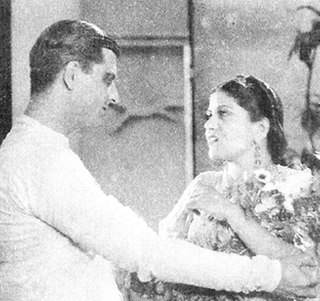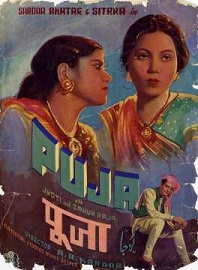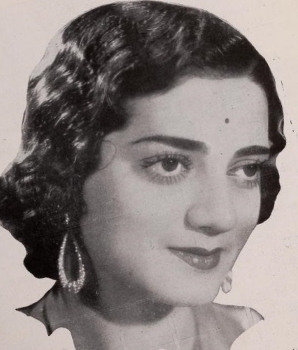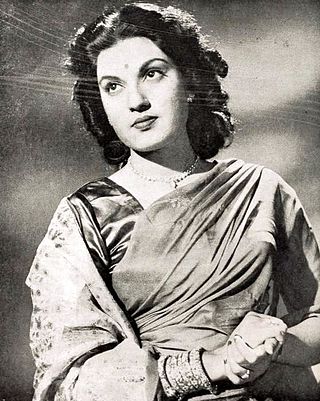Musafir is a 1940 social Hindi language film directed by Chaturbhuj Doshi. Produced by Ranjit Studios, the music was by Gyan Dutt and it starred Noor Mohammed Charlie, Khursheed, Ishwarlal and Yakub.

Sasural is a Bollywood film. It was released in 1941. The film was directed by Chaturbhuj Doshi for Ranjit Movietone. The story was by Gunvantrai Acharya with dialogues by R. S. Rammyae. Cinematographer was G. G. Gogate with audiography by C. K. Trivedi. Gyan Dutt was the music director, with lyrics by D. N. Madhok. The cast included Motilal, Madhuri, Nurjehan, Miss Iqbal, Kantilal, Tarabai, Bhagwandas, and Urmila.
Armaan (transl. Desire) also called Arman, is a Bollywood film. It was released in 1942. Arman was the first film that Kidar Sharma directed for Ranjit Studios and also his first in Bombay since his shift from Calcutta. The story, dialogue and lyrics were also by Sharma. It had music by Gyan Dutt. The cinematographer was D. K. Ambre. The cast included Motilal, Shamim, Nagendra Majumdar, Bhagwandas, and Rajkumari.

Watan (transl. Country) is a 1938 Hindustani costume drama film directed by Mehboob Khan. Produced by Sagar Films, the film had story by Mehboob Khan and Wajahat Mirza. The cinematographer, as for most Sagar films was Faredoon Irani. Following the successful music of Manmohan (1936), Sagar Movietone retained Anil Biswas as the in-house music director, scoring music for Watan along with other releases of the time from the studio. The cast of the film included Kumar, Bibbo, Maya Banerjee, Yakub Lala, Sitara Devi and Kayam Ali.
Aap Ki Marzi is 1939 Hindi romantic comedy film directed by Sarvottam Badami. The film was produced under the Sudama Productions banner. The music composer was Gyan Dutt with lyrics credited to Pyare Lal Santoshi and S. P. Kalla. It starred Motilal, Sabita Devi, Khursheed, K. N. Singh, Mazhar Khan, Vasanti and Sunalini Devi. This was director Badami's second comedy film; he had earlier directed the comedy Teen Sau Din Ke Baad (1938) which turned out be a box office success. Aap Ki Marzi was based on the MGM produced, Edward Buzzell directed film Paradise for Three (1938) from Erich Kastner's novel.
Kokila (transl. Nightingale) is a 1937 Hindi social family drama film directed by Sarvottam Badami. The music was composed by Anil Biswas with lyrics written by Siddiqui and Zia Sarhadi. The story was adapted from the well-known novel Kokila, written by Gujarati writer Ramanlal Vasantlal Desai. The film starred Motilal, Sabita Devi, Shobhna Samarth, Maya Bannerjee, Sitara Devi, Pesi Patel, Siddiqui and Kayam Ali.
Chingari (transl. Embers) is a 1940 social Hindi film directed by Sarvottam Badami. Made under the banner of Sudama Productions, the film had music by Gyan Dutt. Prithviraj Kapoor shifted from New Theatres Ltd. Calcutta to Bombay, where he worked under Badami in two films, Sajani and Chingari both made in 1940. The cast included Prithviraj Kapoor, Sabita Devi, E. Billimoria, Meera, Khatoon and Keshavrao Date.
The Secretary is a 1938 Hindi-language Indian comedy film directed by Chaturbhuj Doshi. The film was produced by Chandulal Shah under the Ranjit Pictures banner. The music was provided by Gyan Dutt with lyrics by Pyare Lal Santoshi. The main cast was Noor Mohammed Charlie, Trilok Kapoor, Madhuri, Kalyani Das, Waheedan Bai and Rajkumari.

Bharosa (Trust) is a 1940 Hindi/Urdu social melodrama film produced and directed by Sohrab Modi. Made under the Minerva Movietone banner, the story and lyrics were by Lalchand Bismil, with cinematography by Y. D. Sarpotdar. The music was composed by G. P. Kapoor, and the cast included Chandra Mohan, Sardar Akhtar, Mazhar Khan, Sheela, Maya Devi and Eruch Tarapore.

Holi is a 1940 Hindi/Urdu social drama film directed by A. R. Kardar. Holi was produced by Ranjit Movietone and had music composed by Khemchand Prakash with lyrics by D. N. Madhok. It had Khursheed and Motilal starring in the lead with Sitara Devi, Ishwarlal, Keshavrao Date, Dixit, Ghory and Manohar Kapoor.

Baghban (Gardener) is a 1938 Hindi/Urdu family drama film directed by A. R. Kardar. The story was by Begum Ansari with script and screenplay by Kardar. Film's music was composed by Mushtaq Hussain with lyrics by Mirza Shauq. The cast included Nandrekar, Bimla Kumari, Nazir, Sitara Devi, K. N. Singh, Wasti and Ashraf Khan.

Pooja (Worship) is a 1940 Indian Hindi/Urdu-language psychological drama film directed by A. R. Kardar. The music director was Anil Biswas, with lyrics by Khan Shatir Ghaznavi. Produced by National Studios, the story, screenplay and dialogue writer was M. Sadiq and the cinematographer was P. G. Kukde. The film starred Sardar Akhtar, Zahur Raja, Sitara Devi, Jyoti, Sankatha Prasad, Sunalini Devi, Bhudo Advani and Baby Meena.

Thokar also called The Kick is 1939 Hindi/Urdu film directed by A. R. Kardar. Produced by Chandulal Shah for his production banner Ranjit Movietone, it had music by Gyan Dutt. The story writer was M. Sadiq, with cinematography by Gordhanbhi Patel. The cast included Kumar, Ishwarlal, Madhuri, Yakub, Noor Mohammed Charlie, Ram Marathe, Waheedan Bai and Dixit.

Jeevan Prabhat is a 1937 Hindi film social drama, produced by Bombay Talkies and directed by Franz Osten. The music director was Saraswati Devi with lyrics and dialogues by J. S. Casshyap. The screenplay was by Niranjan Pal. The film's "star value" was Devika Rani, with Kishore Sahu making his debut as an actor in the film. The cast included another debutant, Renuka Devi, with Mumtaz Ali, Maya Devi and M. Nazir.

Bibbo was a music composer, singer and actress who worked in both Indian and Pakistani films. She acted in Indian cinema from 1931 to 1947 before moving to Pakistan, following Partition of India in 1947. She started her acting career with Ajanta Cinetone Ltd. in 1933, working with directors like M. D. Bhavnani and A. P. Kapoor. She was one of the top leading ladies of the 1930s along with actresses like Devika Rani, Durga Khote, Sulochana, Mehtab, Shanta Apte, Sabita Devi, Leela Desai and Naseem Banu. She was referred to as "one of the most important female stars of the 1930s and 1940s". Her fame had her featured in the lyrics of a popular song from the film Gharib Ke Lal (1939) sung by Mirza Musharraf and Kamla Karnataki, with music by Sagheer Asif and lyrics by Rafi Kashmiri. "Tujhe Bibbo Kahoon Ke Sulochana", where Sulochana referred to another popular actress of the time. This was the first time a song featuring famous actors was used in the lyrics of a film song.

Chaturbhuj Doshi (1894–1969) was a Hindi and Gujarati writer-director of Indian cinema. He was one of the top Gujarati screenplay writers, who helped script stories for the Punatar productions. He is stated to be one of the leading figures who launched the Gujarati film industry with work on notable films like Gunsundari (1948) and Nanand Bhojai (1948). Doshi, was “well known” for his family socials and had become “a celebrity in his own right”. He made a name for himself as a journalist initially and was referred to as the "famous journalist" and publicist by Baburao Patel, editor of Filmindia.

Sabita Devi (1914–1965) was a Hindi film actress in Indian cinema. She is stated to be one of the "prominent" leading ladies of the "pioneering era" of Indian cinema along with Mehtab, Bibbo, Durga Khote, Gohar, Devika Rani and Seeta Devi. A Jewess by birth, she changed her name to find acceptability in Hindi cinema like the other Anglo-Indian and Jewish actresses of her time, Sulochana, Seeta Devi, Madhuri, and Manorama. After initially working with British Dominion Films Ltd., Calcutta, she shifted to Bombay and performed mainly in films produced by Sagar Movietone with her co-star in most films being Motilal. Some of the popular films with Motilal were Dr. Madhurika (1935) and Kulvadhu (1937) directed by Sarvottam Badami. Their first film together was Shaher Ka Jadoo (1934), which was also Motilal's debut film, and then Lagna Bandhan (1936) both directed by Kaliprasad Ghosh. She acted in Silver King (1935) with Motilal. It was an action film directed by C. M. Luhar, which became a "huge success".

Gorakh Aya is a 1938 Hindi mythology film from Ranjit Movietone. It was the debut directorial venture for Chaturbhuj Doshi, who had made a name for himself as a journalist and publicist. The screenplay was by Gunvantrai Acharya, with dialogues by Pyare Lal Santoshi. The cinematographer was Krishna gopal and music was composed by Gyan Dutt.

Munawar Sultana was an Indian cinema actress, who acted in Hindi films. She is cited as one of the "popular" actresses of the late 1940s to early 1950s period, along with Noor Jehan, Swarnalata and Ragini. Her specialty was playing a selfless woman, enduring the rough treatment meted by her husband and family, but who eventually "brought her erring husband back home".

Mazhar Khan was an actor, producer, and director in Indian Cinema. He began his career as a police officer, which he left to study law for a short period. After abandoning his studies, he came to Bombay and started his career in cinema with the silent film Fatal Garland (1928) opposite the top actress of the time, Ermeline. He became a popular actor, gaining success in several silent films. During his stint in silent films he worked with directors such as Bhagwati Prasad Mishra, Ezra Mir, Moti P. Bhagnani, R. S. Chowdhary, and M. D. Bhavnani. Magazines in the 1940s compared Khan to Hollywood actors such as Paul Muni, Bela Lugosi and Boris Karloff.














